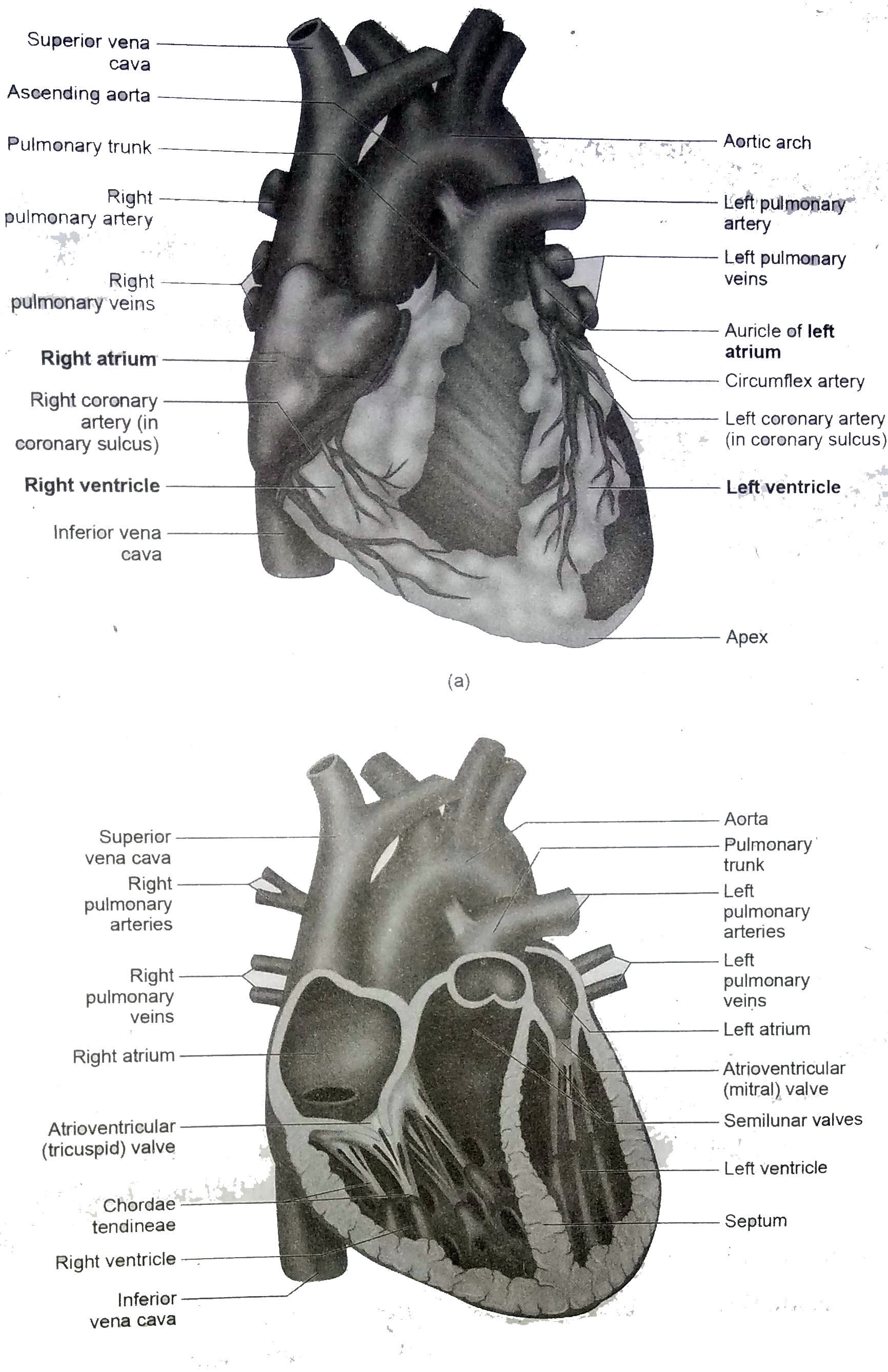Draw a labelled diagram of the internal structure of Human Heart. Solution in Tamil
The structure of the heart was deseribed by Raymond de Viessens, in 1706. Human heart is made of special type of muscle called the cardiac muscle. It is situated in the thoracic cavity and its apex portion is slightly tilted towards left. It weighs about 300g in an adult. The size of our heart is roughly equal to a closed fist. Heart is divided into four chambers, upper two small auricles or atrium and lower two large ventricles. The walls of the ventricles are thicker than the auricles due to the presence of papillary muscles. The heart wall is made up of three layers, the outer epicardium, middle myocardium and inner endocardium. The space present between the membranes is called pericardial space and is filled with pericardial fluid. The two auricles are separated by inter auricular septum and the two ventricles are separated by inter ventricular sepatated by inter ventricular septum. The separation of chambers avoids mixing of oxygenated and deoxygenated blood. The auricle communicates with the ventricle through an opening called uriCulo ventricular aperture which is guarded by the auriculo ventricular valves. The opening between the right atrium and the right ventricle is guarded by the tricuspid valve (three flaps or cusps), whereas a bicuspid (two flaps or cusps) or mitral valve guards the opening between the left atrium and left ventricle. The valves of the heart allows the blood to flow only in one direction, i.e., from the atria to the ventricles and from the ventricles to the pulmonary artery or the aorta. These valves prevent backward flow of blood.

The opening of right and left ventricles into the puimonary artery and aorta are guarded by aortic and pulmonary valves and are called semilunar valves. Each semilunar valve is made of three half-moon shaped cusps. The myocardium of the ventricle is thrown into irregular muscular ridges called trabeculae corneae. The trabeculae corneae are modified into chordae tendinae. The opening and closing of the semilunar valves are achieved by the chordae tendinae. The chordae tendinae are attached to the lower end of the heart by papillary muscles. Heart reccives deoxygenated blood from various parts of the body through the inferior venacava and superior venacava which open into the right auricle. Oxygenated blood from lungs is drained into the left auricle through four pulmonary veins.
Topper's Solved these Questions
- BODY FLUIDS AND CIRCULATIONBOOK - FULL MARKSCHAPTER - BODY FLUIDS AND CIRCULATIONEXERCISE - ADDITIONAL QUESTIONS SOLVED ( Fill in the Blanks)
76 Videos
- BIOMOLECULESBOOK - FULL MARKSCHAPTER - BIOMOLECULESEXERCISE - ADDITIONAL QUESTIONS SOLVED (Higher Order Thinking Skills)
16 Videos
- CELL CYCLEBOOK - FULL MARKSCHAPTER - CELL CYCLEEXERCISE - ADDITIONAL QUESTIONS SOLVED (Higher Order Thinking Skills)
12 Videos
Similar Questions
The tissue fluid that surrounds the cell is ........
View SolutionIn which form does the glucose is stored in animal cells? Specify the cells?
View SolutionGiven that the average duplication time of E. coli is 20 minutes. How much time will two E. coli cells takes to become 32 cells?
View SolutionDraw a diagram of the external structure of human heart (front view) and label the parts.
View SolutionDraw a diagram to show the internal structure of human heart. Label only one heart chamber, any two heart valves and any three other structures.
View SolutionDraw a well labelled diagram of human heart to show its internal structure.
View SolutionDraw a labelled diagram of human heart.
View SolutionWith the help of a labelled diagram describe the internal structure of human heart.
View SolutionWith the help of well labelled diagram describe the internal structure of human heart .
View Solutionमानव हृदय की आंतरिक संरचना का स्वच्छ नामांकित चित्र बनाइये।
View SolutionDraw a well labelled diagram of internal structure of human heart.
View Solution(a)Draw a labelled diagram of internal structure of human heart.
(b) What are chordae tendinae? Give their function.
View SolutionDraw a labelled diagram of the internal structure of Human Heart.
View SolutionDraw a labelled diagram of human heart.
View SolutionDraw a neat, labelled full page diagram: Internal structure of human heart.
View SolutionDraw and label the internal structure of Heart.
View Solution
